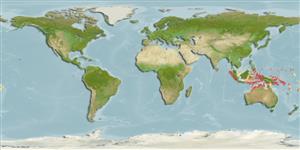>
Gobiiformes (Gobies) >
Gobiidae (Gobies) > Gobiinae
Etymology: Eviota: No etymology given, suggested by Christopher Scharpt: from Latin 'eu' for 'true' and 'iota' for anything very small, in combination 'truly very small' referring to it as being the smallest vertebrate at the time it has benn described by Jenkins (thus, making the suggestion by Scharpt plausible..
Environment: milieu / climate zone / depth range / distribution range
Sinh thái học
Biển Cùng sống ở rạn san hô; Mức độ sâu 3 - 20 m (Ref. 90102). Tropical; 8°N - 18°S
Western Pacific: Japan, Palau, Federated States of Micronesia, Guam and Northern Mariana Islands, Vietnam, Indonesia; south to Rowley Shoals in the Timor Sea, Papua New Guinea, and Solomon Islands.
Bộ gần gũi / Khối lượng (Trọng lượng) / Age
Maturity: Lm ? range ? - ? cm
Max length : 2.1 cm SL con đực/không giới tính; (Ref. 1602)
Các tia vây lưng cứng (tổng cộng) : 7; Các vây lưng mềm (tổng cộng) : 7 - 9; Tia cứng vây hậu môn: 1; Tia mềm vây hậu môn: 6 - 7. Characterized by dark purplish brown body color with three white spots anteriorly on middle of side; presence of series of small white spots beginning on nape, continuing along base of dorsal fin and ending on dorsal surface of caudal peduncle; caudal fin base with red-edged black spot; iris reddish; first four dorsal spines elongate or filamentous in male; all pectoral rays unbranched; longitudinal scale series 21-23; ctenoid scales, absent on head, nape and pectoral fin base; separated pelvic fins, thin membrane joining bases; well developed fifth pelvic ray, 50-70% length of fourth ray; 3-6 branches of fourth pelvic ray; depth of body 3.6-5.0 in SL (Ref. 90102).
Inhabits silty sheltered reefs (Ref. 1602). Reported to be associated with the mushroom Heliofungia actiniformis (Ref. 91291).
Life cycle and mating behavior
Maturities | Sự tái sinh sản | Spawnings | Egg(s) | Fecundities | Ấu trùng
Myers, R.F., 1991. Micronesian reef fishes. Second Ed. Coral Graphics, Barrigada, Guam. 298 p. (Ref. 1602)
IUCN Red List Status (Ref. 130435)
Threat to humans
Harmless
Human uses
Các công cụ
Special reports
Download XML
Các nguồn internet
Estimates based on models
Preferred temperature (Ref.
123201): 27.6 - 29.4, mean 28.8 °C (based on 934 cells).
Phylogenetic diversity index (Ref.
82804): PD
50 = 0.5000 [Uniqueness, from 0.5 = low to 2.0 = high].
Bayesian length-weight: a=0.00708 (0.00333 - 0.01504), b=3.09 (2.92 - 3.26), in cm total length, based on LWR estimates for this (Sub)family-body shape (Ref.
93245).
Mức dinh dưỡng (Ref.
69278): 3.1 ±0.3 se; based on size and trophs of closest relatives
Thích nghi nhanh (Ref.
120179): Chiêù cao, thời gian nhân đôi của chủng quần tối thiểu là dưới 15 tháng (Preliminary K or Fecundity.).
Fishing Vulnerability (Ref.
59153): Low vulnerability (10 of 100).
Nutrients (Ref.
124155): Calcium = 472 [191, 1,637] mg/100g; Iron = 1.78 [0.71, 4.27] mg/100g; Protein = 17.5 [15.4, 19.5] %; Omega3 = 0.102 [0.030, 0.331] g/100g; Selenium = 35.4 [8.8, 118.5] μg/100g; VitaminA = 112 [19, 638] μg/100g; Zinc = 5.24 [2.67, 9.17] mg/100g (wet weight);
